“Niet naar Frankrijk” werd “Ook niet naar Spanje”. Duitsland dan? Of Tsjechië? Een week voor vertrek viel pas de vlag – Slovenië dit jaar. Een stukje voormalig Joegoslavië dat veel mensen enkel kennen als tussenstop op doorreis naar Kroatië, heb ik de afgelopen weken geleerd.
De eerste plek waar dat kwartje viel was in Lesce, een klein dorpje vlak bij het onder toeristen bekendere Bled, in het noorden van Slovenië, een kilometer of 40 onder de grens met Oostenrijk.

In Lesce wordt direct duidelijk dat Slovenië beinvloed is door het Joegoslavië waarvan het ooit onderdeel was, maar ook door buurlanden Italië, Oostenrijk en Hongarije. Overal spreken de mensen naast Sloveens ook Engels en/of Duits en in het westen ook Italiaans. Eten en drinken zijn een mix van Slavisch, Oostenrijks en Italiaans – en in mindere mate dan in Nederland wat uit Amerika is komen overwaaien. Ook veel huizen zijn gebouwd in een stijl die direct aan Oostenrijk of Noord-Italië doet doet denken. De mensen zijn vriendelijk en minder gejaagd dan in die ander twee landen, misschien omdat in een land dat half zo groot is als Nederland en maar 2 miljoen inwoners heeft alles wat gemoedelijker is dan in in dichtbevolkte landen als het onze. Een praatje maken met een ober op een terras, of (zie wat verder naar beneden) een plaatselijke volksmuzikant wordt dan een stuk makkelijker en prettiger.
Een ander voordeel van de lage bevolkingsgraad is dat er veel ruimte is voor mooie en ruige natuur. Slovenië heeft bossen, rivieren, meren waar we in Nederland alleen maar van kunnen dromen, en verder naar het binnenland ook nog een wijnstreek zoals we die uit Frankrijk kennen. Genoeg reden om eens goed rond te kijken dus. Te beginnen met de Sava rivier, die letterlijk om de camping van Lesce heen loopt.
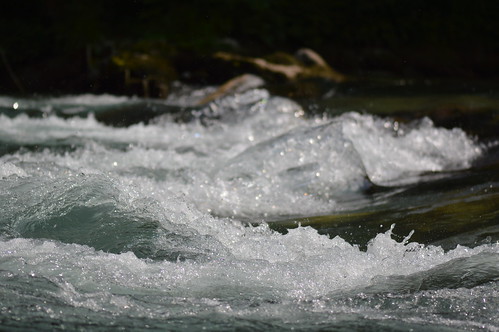
Het water van de Sava rivier bij Lesce
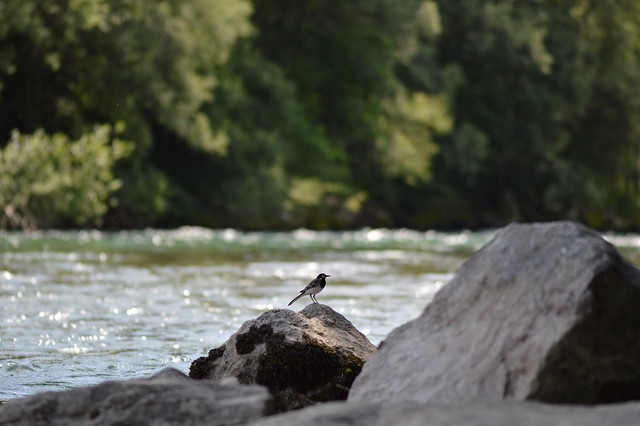
Vogel op een steen langs de Sava bij Lesce
De Sava is een rivier die vol vis zit, wild genoeg is om te kunnen raften en grillig genoeg om een paar dalen met mooie wandelpaden achter te laten.
Een klein half uurtje rijden van Lesce ligt een andere rivier, die door een kloof met de naam Vintgar loopt, de Radovna. Deze kloof is ongeveer 2 kilometer lang en over rotspaden en houten loopbruggen over de hele lengte te begaan. Dat levert de nodige mooie uitzichten op en over het water op.
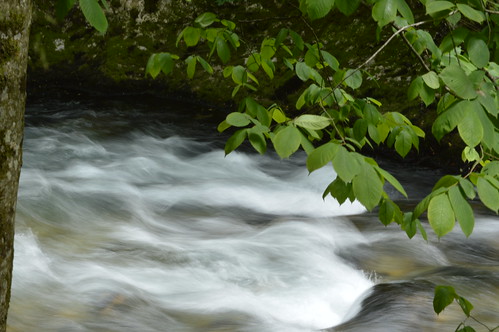
Radovna rivier in de Vintgar kloof

De Radovna laat zich alleen op de foto stil zetten.

De Vintgar kloof is beschermd natuurgebied, en dat betekent helder water….
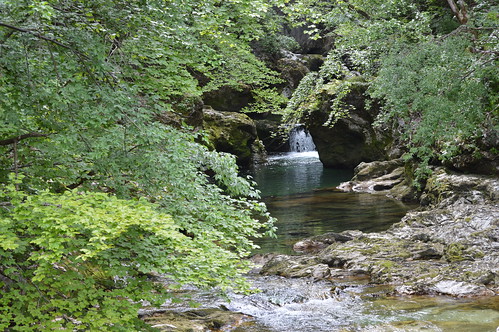
…en mooie doorkijkjes.
Iets verder van Lesce en Bled ligt het Triglav nationaal park, een beschermd natuurgebied rond de Triglav, de hoogste berg van Slovenië. Op mooie dagen is de bergpas die langs de Triglav loopt (een aardige klim naar 1600 meter, die ook bij de Sloveens fietsers erg in trek is) zo druk bezocht dat het eigenlijk niet leuk is om te stoppen. Aan de andere kant van de pas ligt echter de Soca rivier, die ook de moeit waard is. De Soca is op de plek waar wij geweest zijn nog vrij ondiep, maar meer stroomafwaarts wordt ze dieper en wilder – raften op de Soca is voor gevorderden. De bovenloop ligt in een rustig dal, dat nauwelijk bewoond is, en waar prachtige uitzichten op de bergen en over het water te vinden zijn.
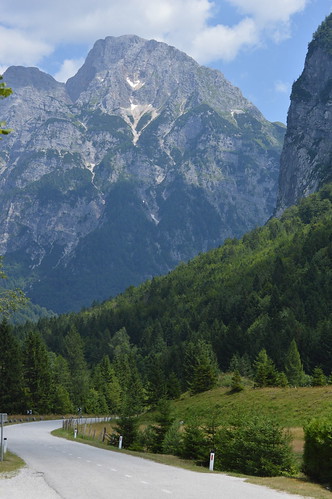
Gezicht op de bergen in het dal van de Soca rivier.

Een huisje aan de Soca rivier. Vanaf de weg alleen bereikbaar via een voetbrug over de rivier
Drie kwartier rijden naar het zuiden vanuit Lesce ligt de hoofdstad van Slovenië, Ljubljana. Deze stad is ongeveer zo groot als Eindhoven qua aantal inwoners, maar de stad is veel ouder. Het oude centrum staat vol met huizen van 2 tot 5 verdiepingen hoog, in vaak vrolijke kleuren. Met een paar leuke winkelstraatjes en de nodige, soms verdekt opgesteld en soms van café naar café in elkaar overlopende terassen is het een gezellige stad.
Aan de randen van de stad liggen een paar grote parkeerterreinen een groot wandelpark, waar je zomaar opeens oog in oog kunt staan met een hagedis, die rustig blijft poseren.

Oude overheidsgebouwen in het centrum van Ljubljana

Het mooiste straatje van het centrum van Ljubljana
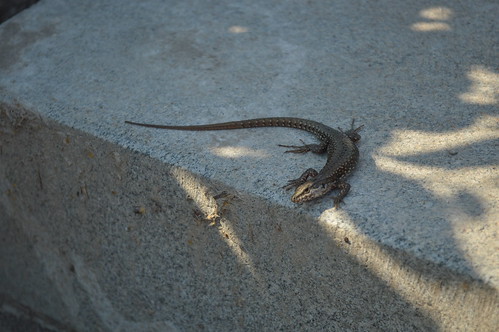
Een vriendelijk poserende hagedis in het stadspark.
Halverwege Lesce en Ljubljana ligt Kranj, een klein, net als Ljubjana wat ouder stadje is bekend om zijn worst en oude gebouwen. Bij een bliksembezoekje hebben we besloten dat de ijskoffie ook in dat rijtje past. Leuk detail: het oude centrum van Kranj is, behalve voor winkeliers, alleen te voet te betreden.

Oud woonwijkje, net buiten het oude centrum van Kranj, met het nieuwe centrum op de achtergrond.
Natuurlijk moesten we ook de ‘grote’ toeristentrekpleister Bled bekijken. Hoewel het daar, ook buiten de Sloveense vakantie, die pas in augustus is, behoorlijk druk was, was de drukte niet te vergelijken met echte toeristenplaatsten. Gelukkig maar.
Bled is een dorpje dat aan, of eigenlijk om een mooi blauw meer met een klein eilandje ligt. Boven het dorp, op een heuvel ligt een kasteel, waar in het verleden de nodige internationale hoogwaardigheidsbekleders op bezoek zijn geweest. Een mooi plaatsje, maar iets te veel op toeristen ingericht, waardoor het de charme van bijvoorbeeld Kranje of Ptuj (zie hieronder) mist.
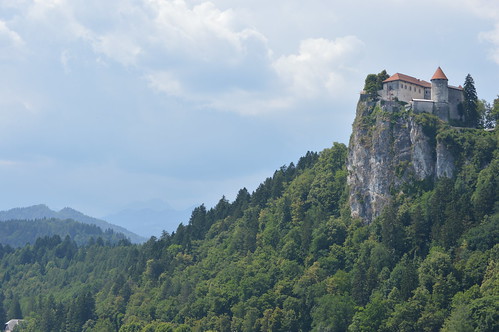
Het kasteel van Bled, uitkijkend over het meer en de bosrijke omgeving.
Wel hebben we in Bled kennisgemaakt met de grillen van de Sloveense weergoden. Het was behoorlijk warm toen we in het dorp waren, rond de 30 graden. We hadden net op een terras iets kouds te drinken besteld toen van het een op het andere moment het water met bakken uit de lucht kwam. In korte tijd stonden er een centimeter of 10 water in de goten langs de straat, en kwam iedereen schuilen op het (overdekte) terras. De temperatuur zakte door de regen een graad of 10 – en een half uur later scheen de zon weer alsof er niet gebeurd was. Resultaat voor ons was een vijvertje voor de tent, en een plas onder de binnentent om dat de buurvrouw op de camping in de regen onze tent had opengemaakt om onze was van de waslijn binnen te gooien. ‘t Hoort erbij – één buitje in een vakantie van 4 weken.
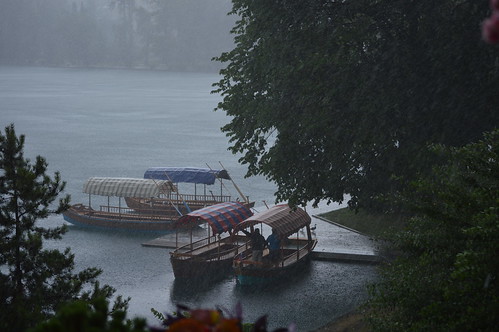
In de stortregen trekken de rondvaargondels op het meer van Bled geen klanten.
Na dit allemaal te hebben gezien bracht het vervolg van de reis ons naar Ptuj, voorlopig mijn favoriete plaats in Slovenië. De oudste stad van Slovenië – al bewoond in het stenen tijdperk en rond het begin van de jaartelling een Romeinse garnizoensplaats. Ptuj ligt aan de oevers van de Drava, de rivier die in Oostenrijk de Drau heet. Vanaf de overkant van de rivier is de stad bereikbaar via drie parallelle bruggen: één voor treinen, een voor gemotoriseerd verkeer en een voor voetgangers en fietsers. Deze laatste komt uit op loopafstand van de Termen, waar een aantal warmwaterbronnen de basis vormen voor een kuuroord annex zwemparadijs, met 12 zwembaden en 8 glijbanen, op de plek waar de oude Romeinen ook al hun termen hadden.
Net als Ljubljana en Kranj heeft ook Ptuj een gezellig oud centrum, met gebouwen uit verschillende tijdperken, en de nodige terrasjes – Sloveense terrassen zitten altijd goed vol. Over de genoemde loopbrug loop je zo dit oude centrum in, pal langs het beste restaurant van de stad, Ribič.
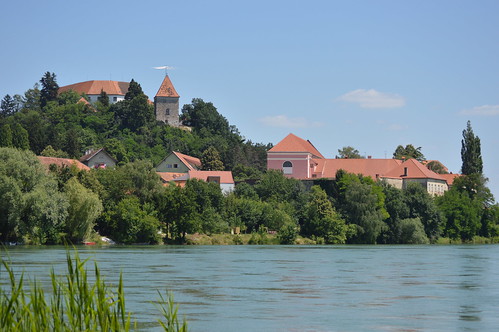
Oud Ptuj, vanaf de overkant van de Drava

De daken van Ptuj, gezien vanaf het kasteel op de heuvel.

Het oudste nog bestaande huis van Ptuj, gebouwd door de Romeinen.
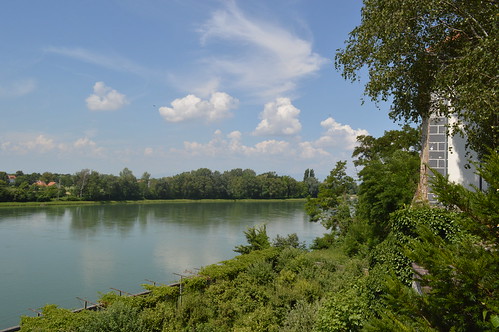
Uitzicht vanuit het klooster in Ptuj, over de Drava
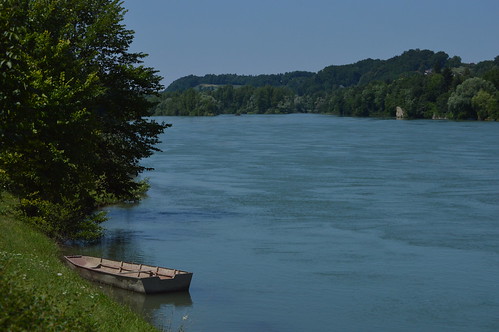
De Drava
Zoals wel meer plaatsen heeft ook Ptuj een oud stadhuis en een moderner stadskantoor. Het oude stadhuis wordt nog gebruikt voor in ieder geval het sluiten van huwelijken. Bij een bezoek aan het centrum kwamen we in een bruiloftsgebeuren terecht. De lokale volksband Ansambel Zargon was het bruidspaar en hun gasten flink in het zonnetje aan het zetten, met de nodige humor – althans, iedereen moest lachen om uitspraken van de bandleider waarvan de Sloveense inhoud ons uiteraard ontging.
Toen bruidspaar en gasten naar binnen gingen kwam de band het terras op, waar wij inmiddels waren neergestreken. Daar werd nog even doorgespeeld, een verkoper van armbandjes in de maling genomen (“Alle armbandjes voor 10 euro, de hele bos!”) en flink gedronken (Spritzer, witte wijn met bronwater). We kregen van bandleider Mitja Bogdan een korte uitleg over de band en de muziek, in het Duits (Engels ging hem net zo slecht af als ons Sloveens) en uiteindelijk gingen we met een CD en een T-shirt van de band weg. Geen muziek voor elke dag, maar op een feestelijke zomeravond met een glas Sloveense witte wijn zeker te pruimen – al zal de herinnering aan de jolige bruiloft daar ook wel in meespelen.

Het oude stadhuis van Ptuj
Die witte wijn is iets waar Slovenië erg trots op is. Een half uur rijden ten oosten van Ptuj ligt het wijngebied van Ormoz en Jeruzalem, waar de beste wijn van Slovenië vandaan komt. 85% van de Sloveense wijn is wit en komt grotendeels uit deze streek. De rode wijnen komen vooral uit het westen, de grensstreek met Italië.
In het gebied rond Ormoz en Jeruzalem ligt een wijnroute die qua uitzicht en goede wijn kan tippen aan de Franse wijngebieden, al is het landschap op veel plaatsen eerder Toscaans dan Frans.
De meeste wijnen zijn halfzoet tot (mier)zoet, met als paradepaardje de wijn van de sipondruif. Niet een verschrikkelijk dure wijn, maar wel met veel variatie in smaak – ik heb sipon geproefd van fris zoet met een zuurtje er in, tot echt zoet. Ook de muskat en riesling zijn prima te drinken, maar (en dat maakt het wel wat gemakkelijker) ook minder sterk gevarieerd in zoetheid. Er is een mooi proefpakket meegegaan naar huis, met de belofte van de verkoopster dat we altijd telefonisch of per e-mail kunnen nabestellen.
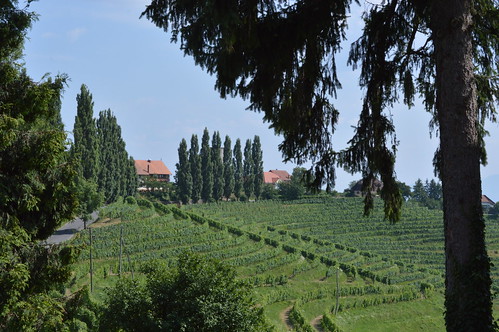
Wijngaarden van Jeruzalem en Ormoz
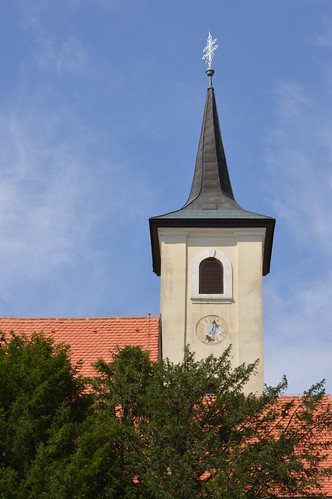
Kerktoren van Jeruzalem, op een heuveltop
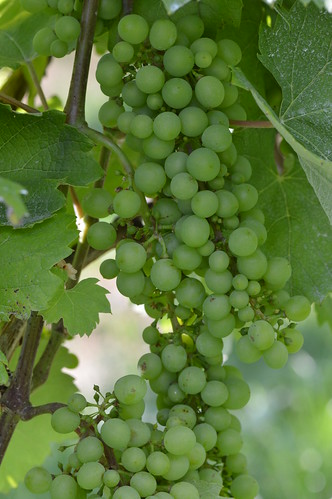
Wijndruiven in Jeruzalem

Een oud huisje, naast de kerk van Jeruzalem
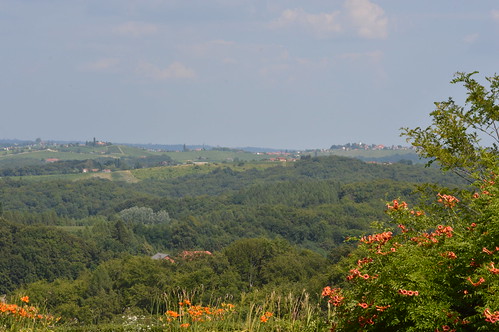
Uitzicht op het Toscaans aandoende landschap rond Jeruzalem
Na Jeruzalem en Ptuj was het tijd voor een bezoek aan Wenen, om de vakantie af te ronden. Daar kom ik een aparte blogpost op terug. Hier sluit ik af met een foto van iets dat we in Nederland maar af en toe zien – een ooievaarsnest op een telefoonpaal, bij Jeruzalem.
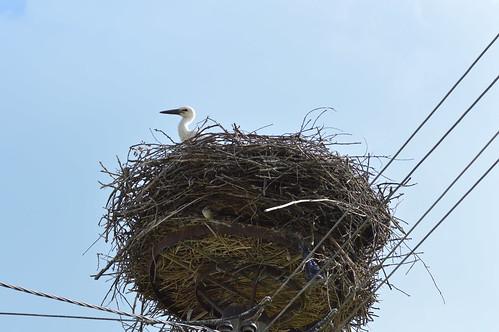
Ooievaarsnest op een telefoonpaal
De foto’s bij dit blog zijn een kleine selectie uit de ruim 800 foto’s die ik in Slovenië heb gemaakt. De mooiste ben ik er nog aan het uitzoeken, die zullen de komende weken worden toegevoegd op mijn Flickr account.

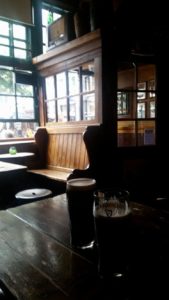
 ogArchives.com
ogArchives.com






















































